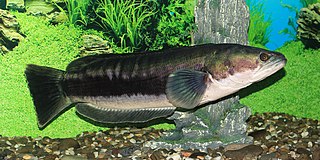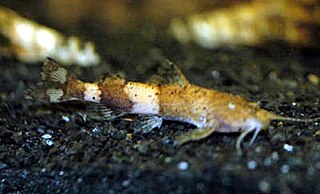
Channa is a genus of predatory fish in the family Channidae, commonly known as snakeheads, native to freshwater habitats in Asia. This genus contains about 50 scientifically described species. The genus has a wide natural distribution extending from Iraq in the west, to Indonesia and China in the east, and parts of Siberia in the Far East. A particularly high richness of species exists in Myanmar (Burma) and northeastern India, and many Channa species live nowhere else. In contrast, a few widespread species have been introduced to several regions outside their natural range, where they often become invasive. The large and medium-sized Channa species are among the most common staple food fish in several Asian countries, and they are extensively cultured. Apart from their importance as a food fish, snakeheads are consumed in some regions as a traditional medicine for wound healing and reducing postoperative pain and discomfort, and collected for the international aquarium pet trade.

Sisoridae is a family of catfishes. These Asian catfishes live in fast-moving waters and often have adaptations that allow them to adhere to objects in their habitats. The family includes about 235 species.

Erethistidae are a family of catfishes that originate from southern Asia. It includes about 45 species.
Oreoglanis is a genus of fish in the family Sisoridae native to Asia. These fish live in fast-flowing streams in China, mainland Southeast Asia and the Indian subcontinent. They are mainly distributed in the Mekong, upper Salween and Irrawaddy River drainages. They range from the Brahmaputra basin to the Lam River drainage in central Vietnam. They are easily distinguished from other catfishes by their strongly depressed head and body and greatly enlarged paired fins that have been modified to form an adhesive apparatus. The flattened shape of these fish and the large pectoral and pelvic fins provide essential adhesion in the fast-flowing waters they live in.

Glyptothorax is a genus of catfishes order Siluriformes of the family Sisoridae. It is the most species-rich and widely distributed genus in the family with new species being discovered on a regular basis. These species are distributed in the Black Sea basin, northern Turkey, south and east to the Yangtze River drainage in China and south throughout Indo-China to Java, Indonesia. They are found in Asia Minor and southwards to Southeast Asia. The genus is very diverse in the Indian subcontinent. Southeast Asian species tend to have restricted distributions.
Pseudolaguvia tenebricosa is a species of catfish. It is only known from a fast-flowing hill stream called Pathe Chaung, near Taungoo in southern Burma.
Erethistoides is a genus of South Asian river catfishes.

Pseudecheneis is a genus of sisorid catfishes native to Asia.
Exostoma is a genus of sisorid catfishes native to Asia. These species are distributed in the Brahmaputra drainage of north-eastern India, and east and south to the Salween drainages in Burma. E. berdmorei is found in the Sittang and Salween drainages in Burma. E. labiatum is known from the Brahmaputra drainage in north-eastern India, but has also been recorded in the Salween drainage in Burma, the Ayeyarwady drainage in China, and the Brahmaputra drainage in Tibet and Burma. E. stuarti is from the Ayeyarwady River of Burma and India; however, it has not been collected since its original discovery. E. labiatum is found in mountain rapids.

Glyptosternon is a genus of sisorid catfishes native to Asia.

Sisor is a genus of catfishes native to Asia.
Pareuchiloglanis is a genus of sisorid catfishes native to Asia. These species are rheophilic catfish chiefly found in the headwaters of major rivers in South and East Asia. They originate from the Brahmaputra drainage in India, east and south to the Yangtze drainage in China and the Annamese Cordillera drainages in southern Vietnam. Two species are known from the Mekong River: P. myzostoma and P. gracilicaudata. Four species are known from the drainage of China: P. abbreviatus, P. gracilicaudata, P. myzostoma and P. prolixdorsalis.

Psilorhynchus is a genus of fish in the family Psilorhynchidae native to South Asia. This genus is the only member of its family. The members of Psilorhynchus are small benthic fishes which occur in rivers and streams with fast to swift currents, hence they are often referred to a torrent minnows. They are distributed in southern Asia, in the Indo-Burma region and the Western Ghats.
Exostoma sawmteai is a species of sisorid catfish from the Pharsih River, which is a tributary of the Tuivai River in the Barak River drainage in Mizoram, northeast India. This species reaches a length of 8.5 cm (3.3 in).
Pseudolaguvia ferula is a species of sisorid catfish from the Tista River in West Bengal, India. This species reaches a length of 2.5 cm (0.98 in).
Pseudolaguvia virgulata is a species of catfish from the Barak River drainage in Mizoram, India. This species reaches a length of 2.9 cm (1.1 in).
Pseudolaguvia fucosa is a species of catfish from the Karnaphuli River drainage system in Mizoram, India. This species reaches a length of 2.7 cm (1.1 in).
Pseudolaguvia nubila is a species of catfish from the Kaladan River drainage system in southern Mizoram, India. This species reaches a length of 3.3 cm (1.3 in).
Pseudolaguvia viriosa is a species of catfish from the Brahmaputra River drainage in India. This species reaches a length of 2.7 cm (1.1 in).

Pseudolaguvia shawi is a species of catfish from waters in Darjeeling, Siliguri Terai and Sikkim in India. This species reaches a length of 3.8 cm (1.5 in).









